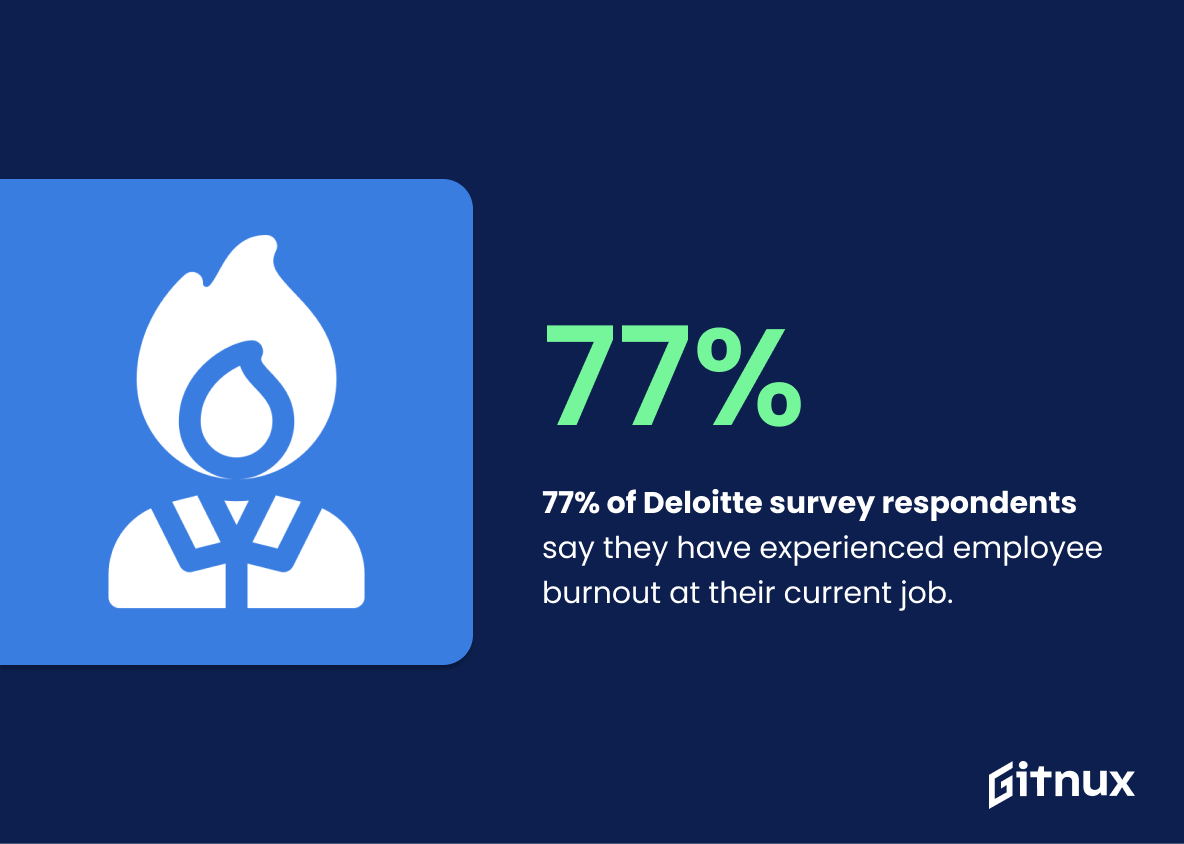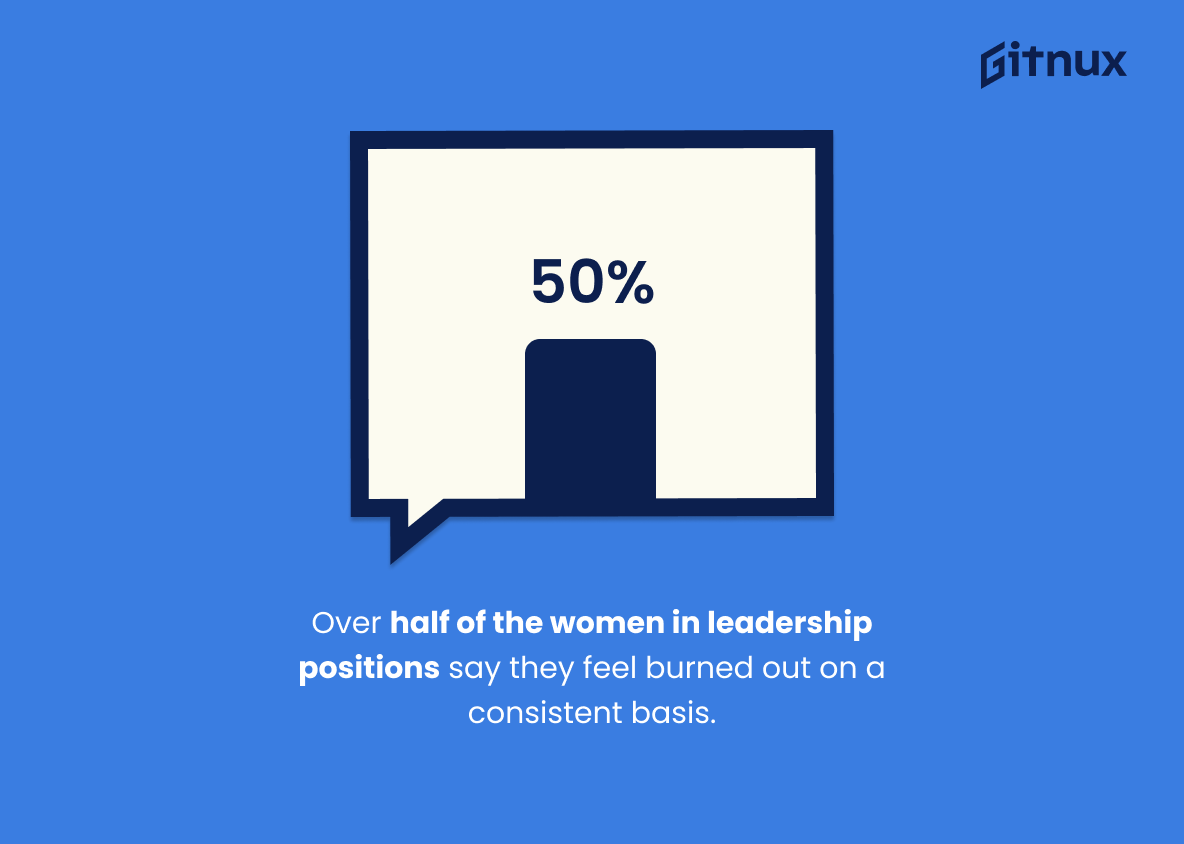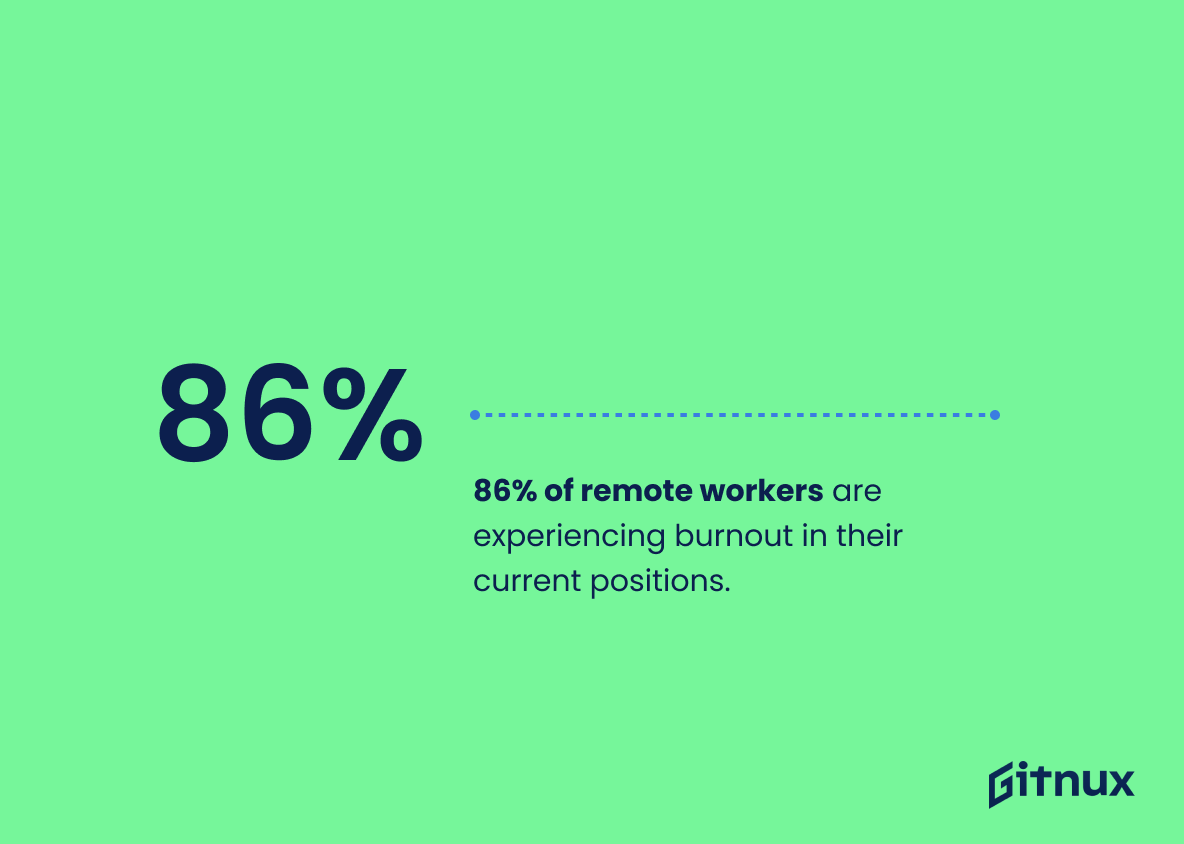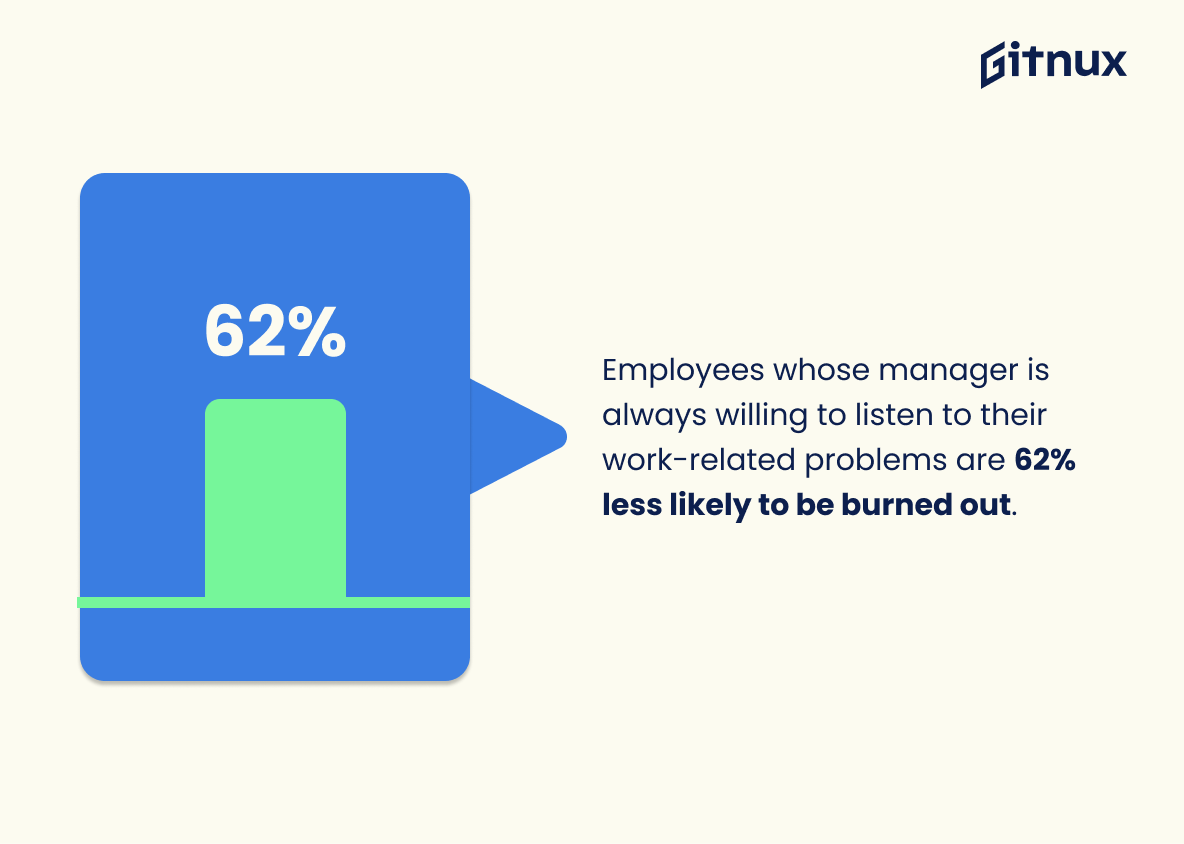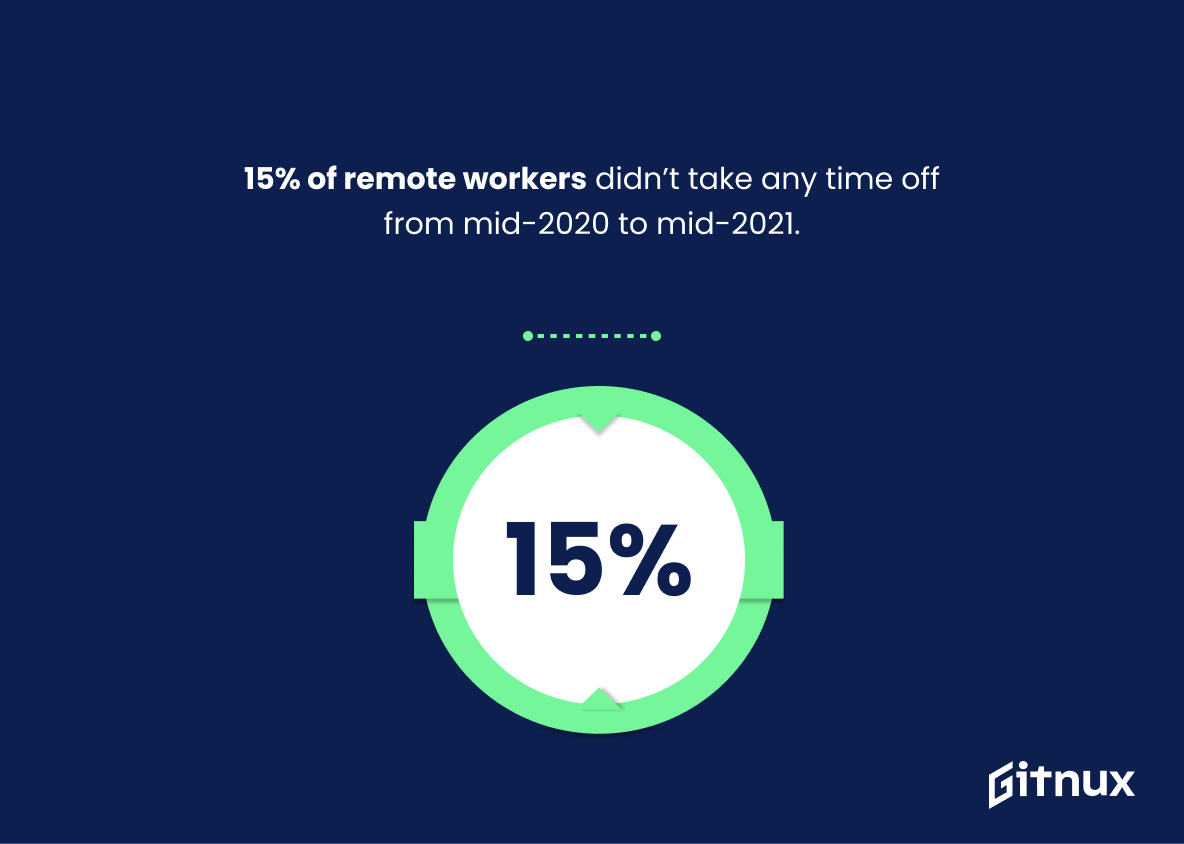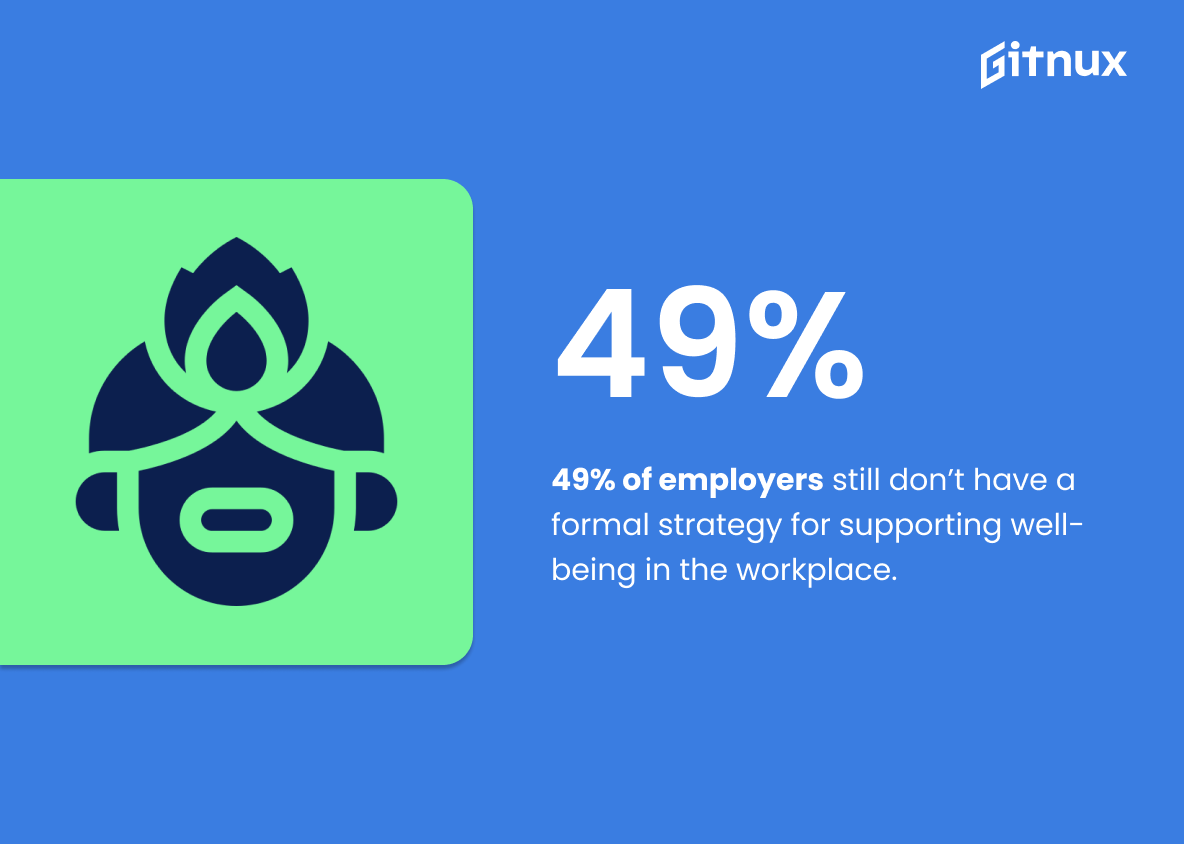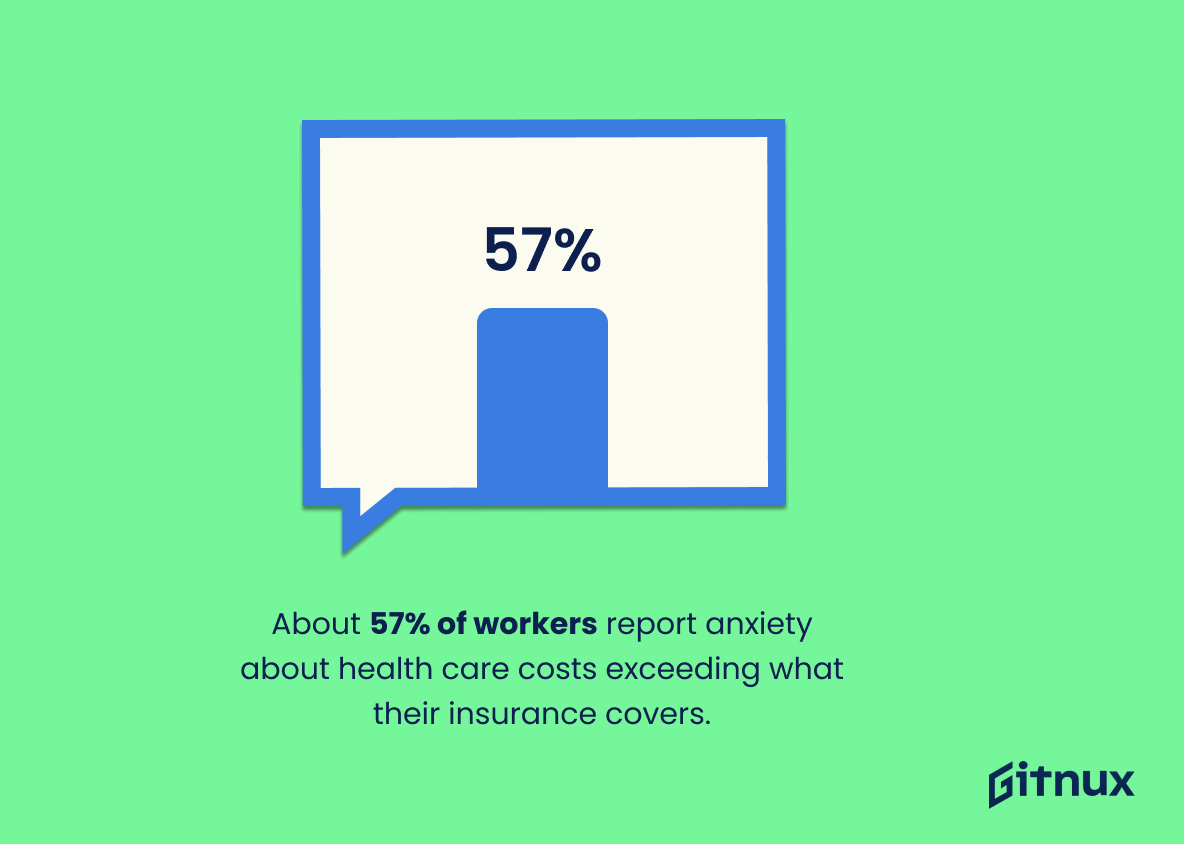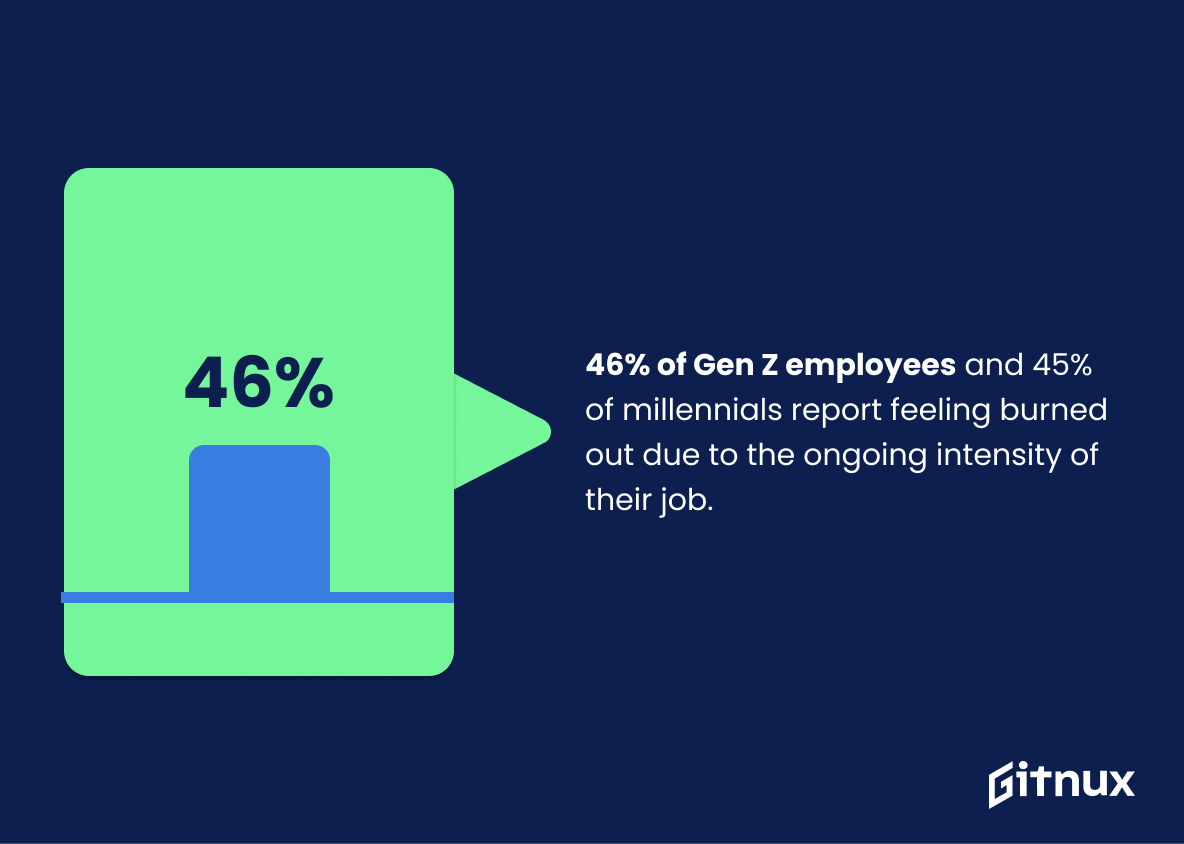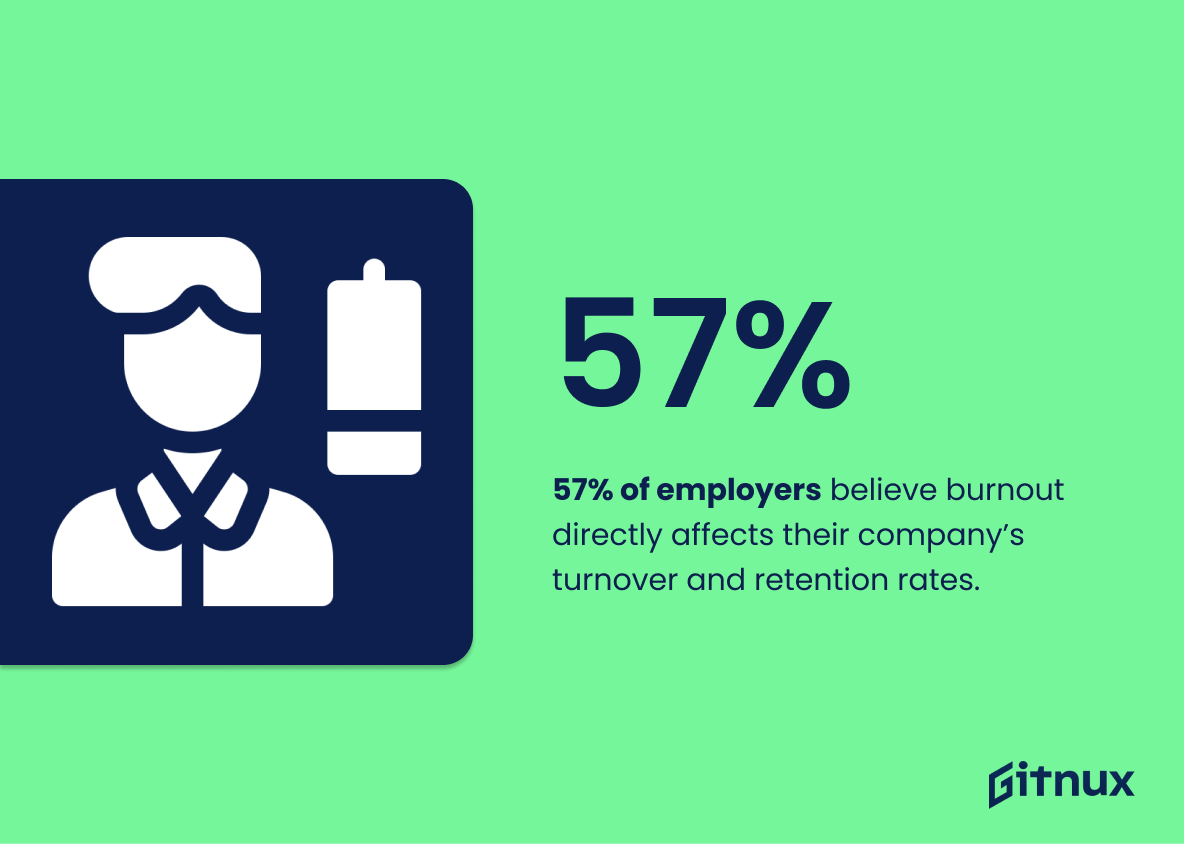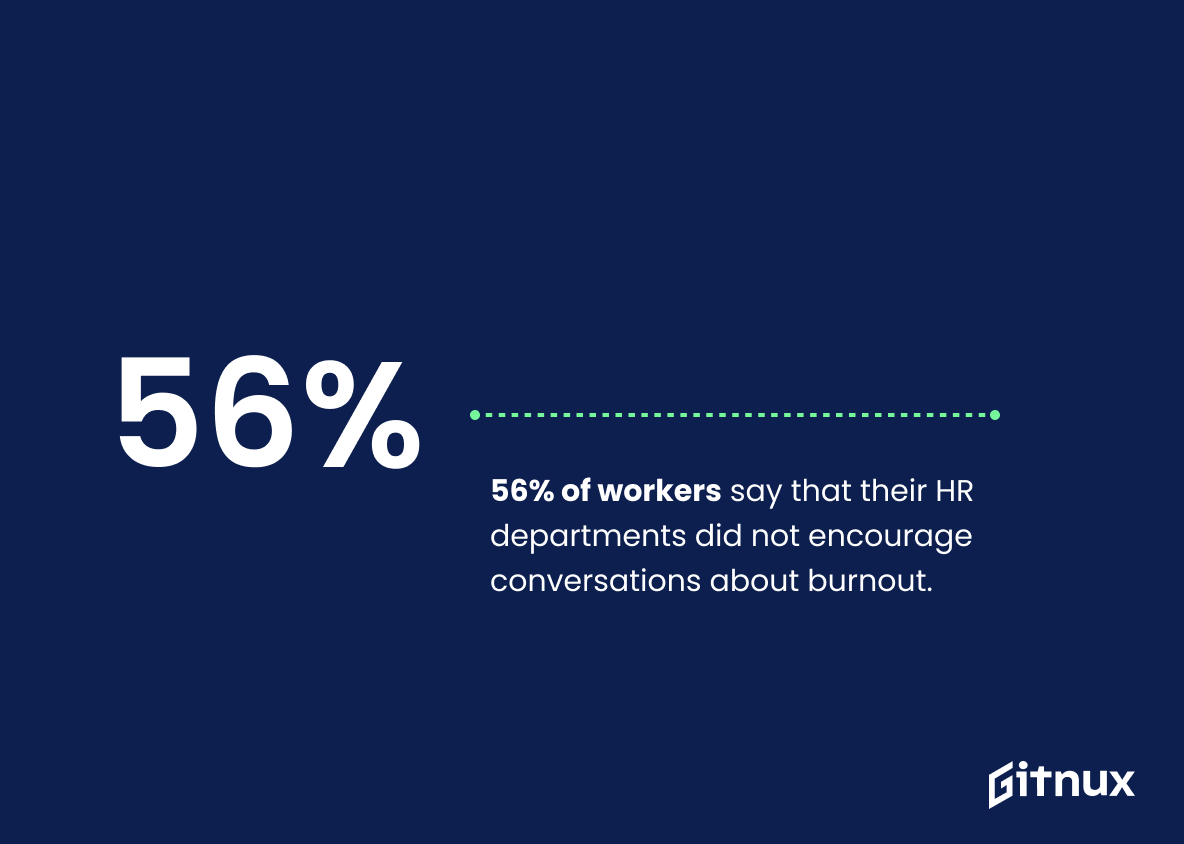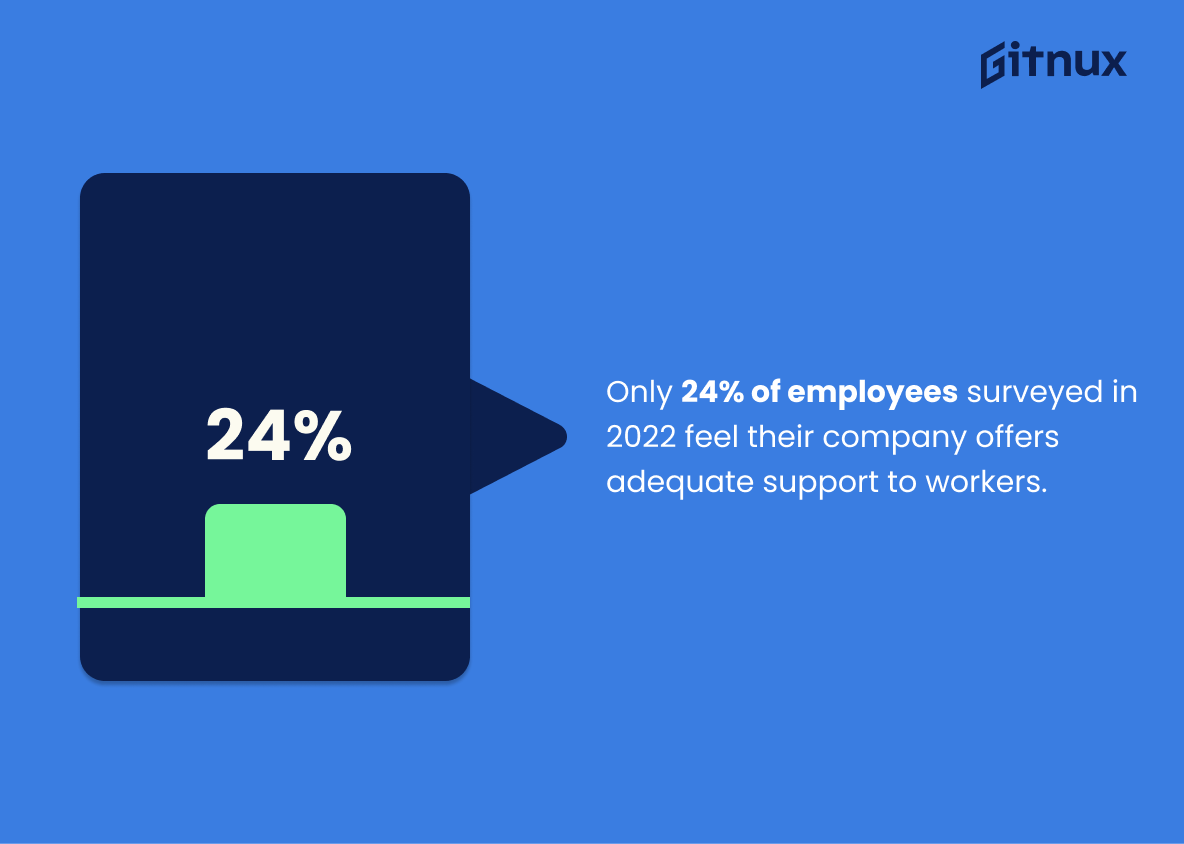Burnout is a growing problem in the modern world, and it affects people of all ages and backgrounds. Recent burnout statistics show that it is becoming more and more common, with a significant number of people reporting feeling overwhelmed and exhausted.
In this article, we will explore the latest burnout statistics, examining the prevalence of burnout and the factors that contribute to it. We will also look at the potential solutions to this problem and how we can help those affected by burnout.
Burnout: The Most Important Statistics
Burned-out employees are 63% more likely to take a sick day and 23% more likely to end up in the Emergency room.
56% of workers say that their HR departments did not encourage conversations about burnout.
General Burnout Statistics
77% of Deloitte survey respondents say they have experienced employee burnout at their current job, with more than half citing more than one occurrence.
Women are more likely to suffer from burnout than men, at a rate of 32% to 28%.
Over half of the women in leadership positions say they feel burned out on a consistent basis.
Employees are more likely to feel burned out if they’re also caring for young children. A study on parental burnout found that 68% of working moms are burned out, compared to 42% of working dads.
86% of remote workers are experiencing burnout in their current positions, while 70% of in-person workers report the same feelings — hybrid workers sit somewhere in the middle at about 81%.
Burnout syndrome accounts for 8% of all occupational illness cases.
Employees whose manager is always willing to listen to their work-related problems are 62% less likely to be burned out.
41% of workers who do a high amount of remote work say they feel high levels of stress “always” or “most of the time.”
15% of remote workers didn’t take any time off from mid-2020 to mid-2021.
Check out our latest Remote Work Statistics
Hospitality, lodging, and food services have the highest rate of burnout in the world. About 80% of those working in this field say their workload was too much to handle. More than 76% of respondents in the industrial, medical, and healthcare industries reported having a large percentage of burnt-out staff, according to Statista.
49% of employers still don’t have a formal strategy for supporting well-being in the workplace.
The main causes of burnout
27% of all respondents are unable to unplug from work, whether due to an inability to take time off or a lack of clear boundaries between the workplace and home.
About 3 out of 5 (57%) workers report suffering high levels of anxiety about health care costs exceeding what their insurance covers. This is most prevalent among Hispanics (69%), including both Gen Z and millennials (65%).
According to Clockify, the bigger the norm for employee hours, the lesser the chance that the company will address burnout. 41% of people who work 50+ hours state that their company doesn’t offer a burnout program at all, and 32% are unsure of it.
67% of remote workers say they feel pressured to always be available. 60% of them are afraid they will lose their jobs if they don’t go above and beyond.
61% of remote workers and 53% of on-site workers now find it more difficult to unplug from work during off-hours. Nearly 40% of all workers check emails outside of regular work hours every day. Only 6% of virtual workers say they “never” check emails after hours.
46% of Gen Z employees and 45% of millennials report feeling burned out due to the ongoing intensity of their job demands and overall work environment.
For 80% of UK workers, the main cause of burnout is a lack of work-life balance. This is closely followed by increased demands from customers (73%), a lack of support and guidance (73%), and a lack of purpose-driven work (69%). An increasing number of workers are quitting or “quiet quitting” their jobs.
Check out our latest Work-Life Balance Statistics
The negative impact of burnout on employees and employers
91% of people say having an unmanageable amount of stress or frustration negatively impacts the quality of their work. 83% say burnout from work can negatively impact their personal relationships.
Burnout affects millennial retention: 84% of millennials say they have experienced burnout at their current job, compared to 77% of all respondents. Nearly half of the millennials say they have left a job specifically because they felt burned out, compared to 42% of all respondents.
57% of employers believe burnout directly affects their company’s turnover and retention rates.
Burned-out employees are 63% more likely to take a sick day and 23% more likely to end up in the Emergency room.
According to Gallup, burned-out employees are 2.6x as likely to be actively seeking a different job. And even if they stay, they typically have 13% lower confidence in their performance and are half as likely to discuss how to approach performance goals with their manager.
Depression costs the U.S. 51 billion USD in absenteeism and lost productivity alone.
56% of workers say that their HR departments did not encourage conversations about burnout.
How do employers deal with this problem?
Nearly 70% of professionals feel their employers are not doing enough to prevent or alleviate burnout within their organization. 21% of employees say their company does not offer any programs or initiatives to prevent or alleviate burnout.
Only 24% of employees surveyed in 2022 feel their company offers adequate support to workers.
36% of workers report their companies are doing nothing to help prevent employees from burning out. 70% of professionals feel their employers could do more to prevent and alleviate burnout.
40% of remote workers say their employers don’t give them the support necessary to manage stress.
1 in 4 millennials and 1 in 5 Gen Zs don’t think their employer takes burnout seriously or is adequately working to address it.
According to Zippia, 48% of remote workers feel as though they have no emotional support from their employers. Only 30% of remote workers completely avoid working on the weekends.
86% of employers say they are still prioritizing mental health, stress, and burnout response, and 26% of employers say they already have a well-being strategy in place.
51% of employers acknowledge that worker mental health concerns have had an impact on their companies in the past year.
56% of workers think their companies show at least a considerable amount of concern for their well-being. Most people with a hybrid work arrangement (70%) agree with this statement.
Burnout statistics in different countries
59% of American workers are experiencing at least moderate levels of burnout.
UK employees’ reports of burnout have skyrocketed to record levels in the past year, and increased by 48% to record levels.
43% of survey respondents in over 100 countries claimed to have experienced stress. According to the report, workers in the US and Canada recorded the highest levels of daily stress globally, at 57%.
People in Eastern European countries feel particularly susceptible to burnout. In Poland, 70% of people have experienced burnout at least once in their lifetime.
Age-wise, Europeans aged between 25 and 34 are the most vulnerable group (72%).
As for their general mental well-being, 29% of Europeans have reported a decline, with people in Austria (37%), Italy (35%) and Portugal (35%) particularly afflicted.
Supplementary Statistics
77% of employees reported experiencing burnout at their current job, according to a 2020 survey.
This serves as a wake-up call to employers and employees alike that burnout is a real issue that needs to be addressed. It also highlights the need for employers to take proactive steps to reduce burnout in their workplaces.
Approximately 1 in 5 employees experienced high levels of burnout in 2019.
Therefore, there is a need for employers to take proactive steps to address the problem and ensure their employees are supported and have access to resources to help them manage their stress levels.
In 2020, 86% of technology professionals experienced burnout at work.
This serves as a warning to those in the technology industry to be mindful of their own mental health and take steps to prevent burnout.
57% of office workers cited too many demands and conflicting priorities as reasons for burnout.
Many office workers are feeling overwhelmed by the sheer number of demands and conflicting priorities they are facing, leading to burnout. Employers need to take steps to reduce the amount of stress and pressure their employees are under, in order to prevent burnout and ensure a healthy and productive workplace.
Healthcare workers have a 35% burnout rate.
Therefore, healthcare workers need better support systems and resources to help them cope with the demands of their job and prevent burnout.
The prevalence of burnout among medical students ranges from 45% to 71%.
Burnout is a serious issue that affects a large portion of medical students, ranging from nearly half to more than two-thirds. This serves as a call to action for medical schools and healthcare organizations to take steps to address burnout and ensure that medical students are supported and have access to resources to help them manage stress and prevent burnout.
About 28% of nurses experience burnout, and this number doubles for critical care nurses.
Due to this, a greater awareness and support for nurses, who are often overworked and undervalued, is important.
Burnout affects up to 50% of teachers within their first five years of teaching.
Those in positions of power therefore have to take steps to ensure that teachers are not only supported, but also given the resources and tools they need to thrive in their profession.
In a study, 39.8% of emergency physicians reported high levels of burnout.
Burnout is a serious issue among emergency physicians. It highlights the need for further research and action to be taken to address the problem and ensure that medical professionals are able to work in a healthy and safe environment.
A survey by Asana revealed that 7 out of 10 employees experienced burnout in 2020.
Thus, this is a widespread issue that affects a large portion of the workforce.
15.1% of veterinarians in the UK experienced severe burnout, according to a 2014 study.
26.6% of dentists suffer from burnout, as reported in a 2013 study.
According to a study, employees who regularly work 12-hour shifts have a 37% increased risk of burnout.
This highlights the importance of taking breaks and ensuring that employees have adequate time to rest and recharge. It also emphasizes the need for employers to be mindful of their employees’ workloads and to provide support and resources to help them manage their stress levels.
Among entrepreneurs, 49% reported experiencing burnout at some point during their careers.
There is a prevalence of burnout in the entrepreneurial world, which serves as a warning to those who are considering starting their own business. It also serves as a call to action for entrepreneurs to take steps to prevent burnout and to seek help if they are feeling overwhelmed.
U.S. businesses lose an estimated $300 billion annually due to burnout and related issues such as high turnover.
This figure is a testament to the fact that burnout is not only a personal issue, but a business issue as well. It is a call to action for businesses to take steps to address burnout and its associated costs.
A 2019 study found that 63% of HR professionals reported burnout in their jobs.
In the construction industry, 78.2% of workers surveyed reported feeling burnout on the job in a 2020 study.
Conclusion
Burnout is a growing problem in the workplace, and it affects individuals and organizations alike. The statistics show that burnout is on the rise, with more than half of workers reporting feeling burned out at least sometimes.
It is important to take steps to prevent burnout before it becomes a problem, such as setting boundaries, taking breaks, and practicing self-care. Organizations should also take steps to reduce burnout, such as providing resources and support for employees.
FAQ
What is burnout?
Burnout is a state of physical, emotional, and mental exhaustion caused by long-term stress.
What are the signs of burnout?
Signs of burnout include fatigue, irritability, insomnia, feelings of hopelessness, and difficulty concentrating.
What causes burnout?
Burnout is typically caused by prolonged stress, such as working too much, not having enough time for yourself, or feeling overwhelmed.
How can burnout be prevented?
Burnout can be prevented by taking breaks, setting boundaries, and getting enough rest.
How is burnout treated?
Burnout is typically treated with counselling, lifestyle changes, and stress management techniques.
Resources
BBC: “Why Gen Z workers are already so burned out”, cited February 2023. (Source)
Clockify: “Career burnout and its effect on health”, cited February 2023. (Source)
CNBC: “Remote work burnout is growing as pandemic stretches on. Here’s how to manage it”, cited February 2023. (Source)
Deloitte: “Workplace Burnout Survey”, cited February 2023. (Source)
EveryoneSocial: “16 Employee Burnout Statistics You Can’t Ignore”, cited February 2023. (Source)
Fortune Media: Many Gen Z and millennial workers feel employers only pay lip service to mental health”, cited February 2023. (Source)
Gallup: “Employee Burnout, Part 1: The 5 Main Causes”, cited February 2023. (Source)
Gallup: “Millennials Are Burning Out”, cited February 2023. (Source)
HR News: “88% of UK workforce have experienced burnout in the past two years”, cited February 2023. (Source)
Indeed: “Employee Burnout Report: COVID-19’s Impact and 3 Strategies to Curb It”, cited February 2023. (Source)
Limeade: “Employee burnout statistics for 2022”, cited February 2023. (Source)
Picked: “10 UK Employee Stress And Burnout Statistics (2023)”, cited February 2023. (Source)
PR Newswire: “Employee burnout is on par with levels at the height of the COVID-19 pandemic; job performance impacted”, cited February 2023. (Source)
Statista: “Industries with the highest employee burnout rate worldwide in 2019”, cited February 2023. (Source)
Strada: “STADA Health Report 2022: Europe experiencing worsening health conditions”, cited February 2023. (Source)
TravelPerk: “Surprising Remote Work Burnout Statistics in 2023”, cited February 2023. (Source)
World Economic Forum: “2020 was a record year for feeling stressed at work”, cited February 2023. (Source)
Zippia: “25 CRUCIAL REMOTE WORK BURNOUT STATISTICS [2023]: HOW TO RECOGNIZE AND AVOID WORKPLACE STRESS”, cited February 2023. (Source)
ZipDo, cited June 2023: Burnout Statistics
